How to fix root-bound cannabis
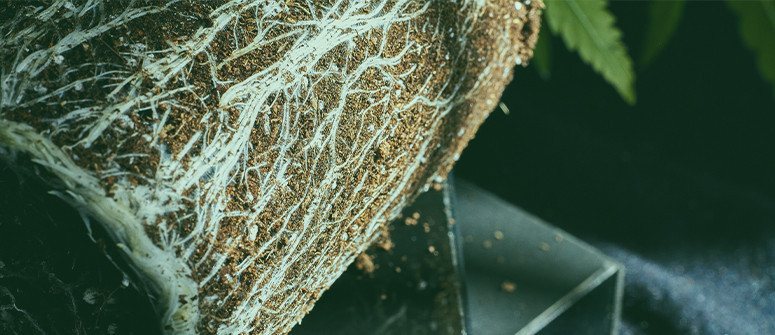
Cannabis grows fast, and sometimes it can get too big for its own pot. While it is fairly easy to prevent, root-bound cannabis is cause for concern, especially if left unmanaged. Learn how to identify, treat, and prevent root-bound cannabis in this comprehensive guide.
Contents:
Cannabis grows very fast, and some strains like to get very big. With all this growth comes significant subterranean root growth too. If a plant outgrows its pot, the roots can form a very dense, tangled ball and become unhealthy, leading to many issues for the whole plant—in this case, they have become “root-bound”.
In this article, we look at how to identify, treat, and prevent root-bound cannabis plants.
What is a root-bound weed plant?
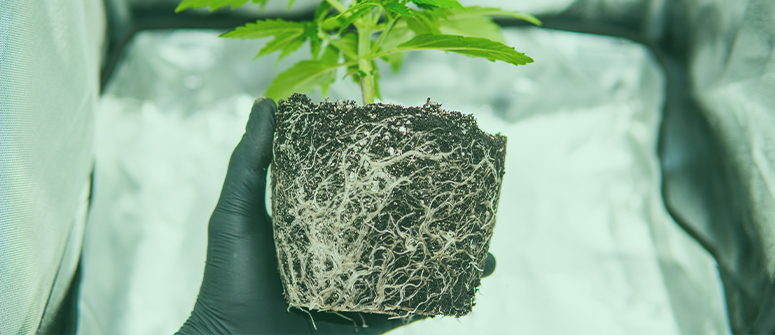
When a marijuana plant becomes root-bound, it means that the root system has outgrown the container (usually a pot) in which it is growing. Once they become too big, roots will begin to curl around the pot in a circle and form a very dense mass, which can cause many problems for the plant.
When growing outdoors in the ground, roots are usually able to spread vertically and laterally as they need to, growing larger as the plant becomes bigger and more mature. When growing in pots, which is the case in most cannabis grows—both indoors and out—there is only finite space in which a plant’s roots can grow.
In order to stop plants from becoming root-bound, growers must pick appropriate-sized containers, and learn how to spot when a plant needs to be transplanted.
Is being root-bound bad for cannabis plants?
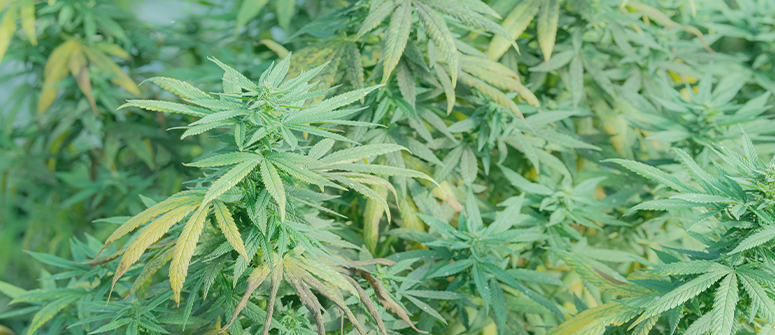
Yes, it is. A healthy root system is crucial, and so a root-bound plant is cause for concern. It stunts their growth, including flower production, and damages their health. In severe cases that are left unremedied, root-bound plants may even die. At the very least, they will be unproductive.
The good news is that, if you spot it in time, you can transplant and save root-bound cannabis, soon returning the plant to its former glory, and giving it the space to thrive even more!
Symptoms and signs of root-bound weed
Diagnosing a root-bound plant requires a little investigation because, as with many cannabis ailments, the symptoms resemble those of many other issues. There are, however, some telltale signs that are unique to root-bound cannabis, which will help you to identify the problem.
Slower growth
Once a root system becomes dense and bound up in a pot, the growth of the plant will slow and stall. This is because a plant’s root system needs to expand in order to accommodate more growth above ground. If the roots can’t grow, the plant will slow its overall growth. The roots are how the plant absorbs food and water, and how it anchors itself securely in the ground, so it won’t continue to grow if the roots aren’t able to keep up.
If you notice that a plant suddenly stops growing during a period where it should be (such as the vegetative stage), then it may well be that it has become root-bound. If the plant is clearly quite large compared to its pot, it’s worth taking a look!
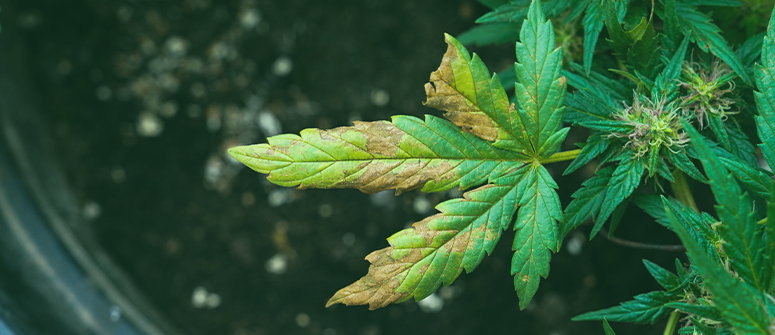
Nutrient deficiency
When cannabis plants become root-bound, they will struggle to absorb enough nutrients to properly feed themselves, which will eventually lead to them developing a nutrient deficiency. There are many symptoms that indicate nutrient deficiencies, depending on the nutrient(s) in question.
But commonly, leaves will begin to discolour if nutrients are running low. Typically, the plant will develop either brown or yellow leaves—or both.
If you spot that your plant has a nutrient deficiency, the obvious first step might be to give it more nutrients. But in the case of root-bound cannabis, this likely won’t be helpful.
If you’re certain you’re feeding it well and there are no pH issues in the soil, then check if it’s root-bound before throwing in more feed, especially if the plant is clearly big compared to its pot.
Wilting and diseases
Root-bound weed may also just become ill, with no clear explanation. This can become apparent if the leaves, branches, and stems begin to wilt, or the plant just takes on a generally sick-looking appearance.
Plants in this condition are also more susceptible to disease, particularly root-related conditions. As the roots are crushed together, disease spreads more easily and fungal/bacterial infections are more likely to take hold and find a comfortable home.
If a plant begins to look unwell and you can’t easily identify why, check the roots. Especially when it comes to infections, treating them fast can make all the difference!
Unsteady plants
Among their many functions, roots keep a plant well anchored to the ground, stopping it from falling over. Plants that outgrow their root systems will quickly become top-heavy and will soon topple over.
If you notice your cannabis plants begin to lean to one side, or otherwise seem unsteady, it may be that the roots are unable to keep up with the growth of the plant, and therefore can’t keep it properly secured.
This is one symptom that immediately suggests that the roots are bound, so it shouldn’t take you long to figure out what’s going on.
Pests
When roots become bound, it causes the plant to become stressed, and stressed plants are more susceptible to infestation. If you notice pests on your plants, it may be that they are root-bound.
This is a tricky one though, as pests can also make a home on totally healthy plants, and so their presence doesn’t immediately indicate some underlying problem. Often, dealing with the pests directly is enough.
In instances where the plants seem otherwise normal, checking the roots may not be the obvious or correct decision. However, if you notice pests along with one or more of the other symptoms mentioned here, especially unsteady plants, visible roots, or fast-drying soil, then it may be that a bound root system is the underlying cause.
Damaged pots or roots through potholes
When roots outgrow their containers, they will take over any space they can find. If your pot has holes in the bottom, then the roots will appear out of these in search of space. This is a really easy way to see if your plants are root-bound—but it’s only possible if you’re using pots with holes in the bottom.
Otherwise, pots might even break as the root system becomes ever more large and dense. If a pot suddenly develops a crack down the side, the plant may be root-bound.
Fast drying or lack of soil
Is your soil drying up incredibly quickly, within a day or two of watering? Or does there appear to just be a general lack of soil?
Root-bound weed absorbs water very quickly, as there are a lot of roots and very little soil. If your soil dries up rapidly, the most likely explanation is that the root system is too large.
Unsure? — Just take a look
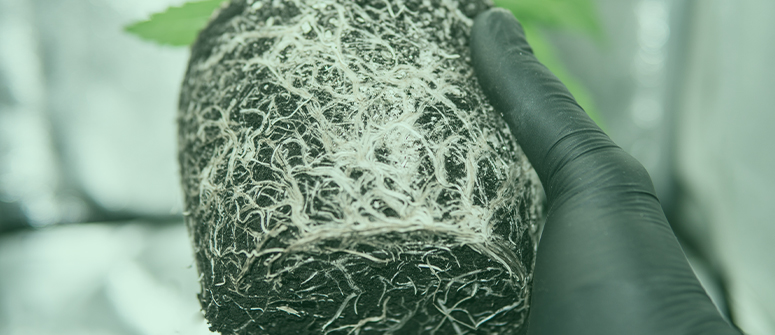
If you suspect your plant is root-bound, you can have a look. Unless it’s very large, it should be possible to slide the roots and soil out of the pot—even if just partially—and take a look at them. By doing this, you can see with your own eyes if your plant is root-bound, rather than trying to determine it from other symptoms.
Once you have it out of the pot, you’ll be able to tell if it's root-bound if there is a dense root ball, and if some of the roots are growing in a circle around the perimeter. If these two signs are present, the plant’s roots are bound. If they’re not, then you’ve got another issue (or no issue).
How to fix root-bound cannabis plants
Once you’ve identified that your plant has become root-bound, you’ll need to transplant it to a larger pot, otherwise its growth will stop and it will become unwell.
As well as transplanting, you’ll need to loosen the root ball so it can begin growing properly again. Once it becomes too dense, it can struggle to free itself without intervention. Below, we’ll show you how to transplant root-bound cannabis.
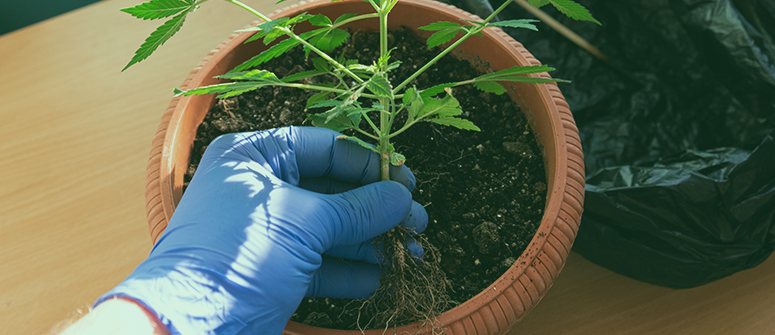
Water the plant
First, water the plant. When transplanting seedlings, it’s better to do it dry, but most growers prefer to transplant larger plants with wet soil, as it helps to keep the root ball together. Although, with root-bound cannabis, the issue is that the root ball is stuck together, so watering is less important.
Prepare a new pot
Next, prepare the new pot. Fill it about halfway with new soil. When choosing a pot, decide if you want a regular or fabric pot, and make sure it’s big enough to properly accommodate the new plant and any remaining growth it has in store.
Remove the plant
Now you need to carefully remove the plant from its current container. First, wash your hands and/or put on a pair of clean gloves. The roots are already vulnerable, and the process of loosening will stress them, so the last thing you want is to transfer pests or disease to them.
Turn the pot on its side or upside down, and gently work the plant out of the pot by pulling at the base of the stem. You should find that everything slides out quite comfortably—you shouldn’t find yourself tugging at it.
Loosen the roots and prune (if needed)
Now you’ll need to loosen the root ball so it can begin to grow properly again. If you plant it as it is, the root system could be so densely bound that it struggles to untangle itself. To help it out, gently massage it so the whole thing loosens and becomes more slack. You don’t want it to be one solid mass.
In serious cases, you may need to make a few vertical incisions down the outside of the root ball. For this, use a very clean and very sharp blade, and cut it downward in two or three places. Try to only cut the smaller, newer growth, and definitely don’t sever the taproot, as this will seriously damage or kill your plants.
If you cut the roots, be aware that this will stress your plants, and you might need to keep them vegging for an extra week or two so that they can properly recover.
Replant
Now, place the plant in the new pot and fill the space with soil. Put enough in to properly support the plant, but don’t make it too dense—you want to make it easy for the roots to start growing outward again!
Water well
Next, water the soil until it’s good and damp (but not soaked), this will help the soil and roots to settle together, and will help to hydrate your plant so it can start recovering and growing.
Reduce plant stress
For a week or two, your plant is going to be in recovery mode. This means that it will already be stressed and expending its energy on this, so don’t stress it by other means. This means no training methods, and taking extra care regarding watering and feeding. It might be able to recover fully from being root-bound and transplanted, but you don’t want to push your plant over the edge!
How to prevent root-bound cannabis
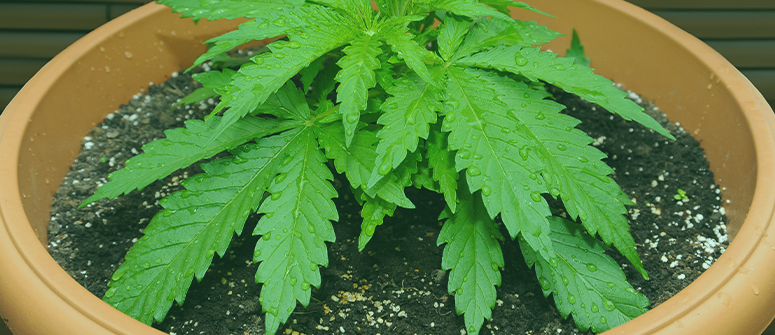
As always, prevention is the best cure, and when it comes to root-bound cannabis, preventing it isn’t difficult. It’s basically about giving your plants a big enough pot at the right time.
A main reason that plants become root-bound is because growers wait too long before transplanting them. It’s much better to transplant before your plants become root-bound, so don’t wait until the last minute, as this will just cause extra stress for you and your plant babies.
Let your cannabis plants flourish freely
While smaller pots are an effective way to control the overall size of a cannabis plant, it’s important to find balance. Most people don’t want to give their plants’ roots too much space because, as well as the pots taking up a lot of space, the plants may become too big for the growing space (or too visible to prying eyes). However, you shouldn’t seek to restrict your plants too much, nor should you wait too long to transplant them.
The good news is that avoiding and treating root-bound cannabis is pretty easy, and so you shouldn’t run into too many problems.




